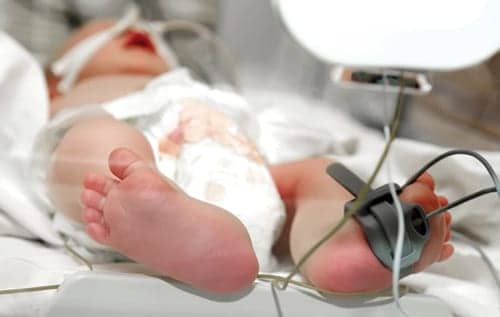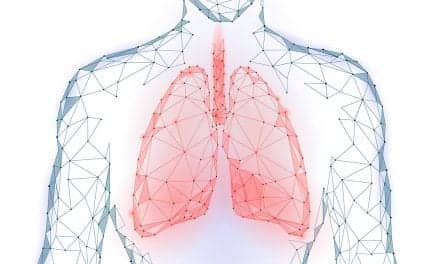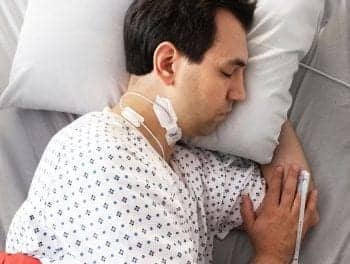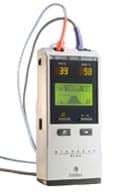Reliable noninvasive measurement of blood oxygen for hypoxic, critical care newborns and children is essential to positive patient outcomes, but monitoring this population can be a challenge.
Pulse oximetry (SpO?) has become one of the standard monitoring practices for a variety of patient populations, including hypoxic neonates, infants and children. However, a 2011 study1 cited some challenges and limitations associated with pulse oximetry that could negatively impact care of neonates and pediatric patients. The study pointed out that practitioners must understand how factors, such as motion, poor perfusion, irregular rhythms, ambient light, skin color, probe position and others, may interfere with measurement accuracy.
Moreover, although noninvasive and considered safe, pulse oximeters emit a small amount of heat. A study2 out of the Pennsylvania Patient Safety Advisory Authority reported that skin integrity problems, from cuts/lacerations and skin discoloration to burns and blisters might occur. To address this issue, medical device manufacturers are working to develop alternative and safer pulse oximetry systems for critical care newborns and children.
Balancing Oxygen Levels
David N. Cornfield, MD, Anne T. and Roger M. Bass Professor of Pulmonary Medicine; director, Center for Excellence in Pulmonary Biology, Department of Pediatrics and (by courtesy) Surgery, Stanford University School of Medicine; chief, Pulmonary, Asthma and Sleep Medicine and medical director, Respiratory Therapy at the Lucille Salter Packard Children’s Hospital at Stanford, has conducted considerable research on critical care infants. “In newborns the evolving sensibility is that the oxygen levels need to be within a given range. You can give two much oxygen, and too little is also problematic,” he said. “Pulse oximetry is an outstanding tool, which has come to the fore. It’s a major tool for observing oxygen saturation and extrapolating data. If pulse oximetry drops below the 86 to 88 range, there’s a dramatic linear decrease in oxygen in the bloodstream representing danger.”
Cornfield continued, “Now there is less lag time with the new pulse oximeters. If there is a decrease in saturation, it’s seen in real time. But I’m not convinced we’ve made a major leap forward in the last 15 to 20 years. There is no real substitute for eyes on the patient.”
Certain situations can challenge the accuracy of pulse oximetry. “Low perfusion, shock and peripheral vasoconstriction make it difficult to get a reading,” said Cornfield. “Measuring serial sample blood gas can be used to validate saturation and provide a true reading. Having an arterial line serves to reassure and validate measures.”
Ideally, Cornfield would like to see an indwelling mini-catheter sampling system developed that would continually provide oxygen, PH and CO? measurement levels in lieu of arterial blood gas. “This would be a significant advance. It would be difficult given the mini needs and engineering challenges, but it’s coming in the next decades,” he said.
Another monitoring strategy involves ventilation via transcutaneous CO? monitor. “But this is more limited by how thick and well developed the skin is. It can’t be used beyond the neonatal stage. The tool is widely discrepant from patient to patient and is not as ubiquitous,” Cornfield said, adding that near infrared spectroscopy is another “promising tool” that measures perfusion in the brain and the CO? and metabolic demands.
Contact-free Monitoring
In some cases, monitoring with any device that comes in contact with the skin can cause problems. Philips Research is developing a breakthrough technology for contactless measurement of vital physiological signals, ie, breathing, pulse and arterial blood oxygenation, simultaneously with motion using optical camera sensors and proprietary patented Philips’ signal processing algorithms. Ihor Kirenko, senior scientist, Patient Care & Measurements, Philips Research, said, “The technology allows monitoring of a health condition of a person without attaching sensors to a body, which makes it very attractive across many healthcare applications, especially for neonatal monitoring, where use of on-body sensors might cause discomfort, skin irritations, and even cross-infections.”
A study3 published in Anesthesia & Analgesia used Philips proprietary camera-based monitoring technology “to measure the light reflected off the foreheads of 41 healthy adults to calculate SpO?.” Much like conventional contact probes, the contactless design provided accurate measurements and did not require individual adjustments.
Philips’ touchless technology is currently being tested on adults as well as on premature neonates in the neonatal intensive care unit (NICU). Kirenko said, “The results of validation of the algorithms for pulse and respiratory signal extraction proved that the contactless monitoring would provide an accuracy on par with the classical contact sensing technologies.” He added that one of the most interesting and important application areas of contactless monitoring is in the NICU. “Therefore, Philips Research, in collaboration with clinical partners, is testing this technology in real-life conditions of the NICU.”
Due to the nature of a neonate’s skin, monitoring without touching the skin presents as an ideal tool. “The main benefits of contactless monitoring are provided by the truly unobtrusive nature of the technology. Since no contact with the skin is required, there is no risk of cross-infection, skin irritation. Since caregivers don’t need to attach sensors, pay attention to cables, connectivity and other aspects of contact sensing, they can focus more on a baby, rather than on the sensors,” Kirenko said. “Moreover, a camera-based monitoring solution allows not only measurement of several vital signs, but also detailed and accurate estimation of motion of a body. Such motion estimation provides information for a more reliable and representative interpretation of the acquired vital signs.”
In spite of the significant benefits of contactless monitoring, there are certain challenges that still exist. Kirenko pointed out that, due to its disruptive nature, the technology is still in the research and advanced development phase. “Although the major fundamental roadblocks have been successfully addressed already, there are still efforts required to bring the technology to the maturity level demanded by healthcare applications,” he said. “For instance, motion robustness and full automatisation of the measurement are among the main current research focuses.”
To date, Philips has successfully tested several elements of the technology, specifically, spot-checking of pulse and respiration rates, on neonates, including in the NICU environment, according to Kirenko. “However, more clinical trials are required to investigate all aspects related to the workflow of contactless monitoring,” he noted.
Dual Monitoring System
A 2012 study4 cited the importance of balanced oxygenation to prevent hypoxia during development, the birth process and in the early postnatal period and emphasized the benefits of cerebral oxygenation, which, at that time, was not available.
Today, that technology has been combined with pulse oximetry to provide a more comprehensive picture of oxygenation. Brian Kane, global marketing manager – acute care, Nonin Medical Inc, pointed out that SpO? and cerebral (rSO?) oximetry measurements offer complementary information and “…tell if the lungs and heart are doing what they are supposed to be doing.” Nonin is the first medical device manufacturer to offer SpO? and rSO? in the same system.
According to Kane, Nonin’s SenSmart System gives a picture of the “supply and demand at the site where oxygen exchange takes place.” He said, “Having this information allows clinicians to provide better treatment options and head off complications.”
Multiple sensors allow clinicians to monitor up to six areas of the body concurrently. Sensors can be placed on the head for uni- or bilateral monitoring of the brain. Kane pointed out that due to their size, preemies can accommodate only one sensor on the head. Other sensors can be placed on one or both kidneys, which provides a “systemic window on perfusion because it’s one of the first organs affected by a state of hypoperfusion.” SenSmart can handle six channels to allow a better idea of what’s happening in the body.
The monitor is color matched with measurement flags related to different functions. “It helps guide the eye as to which sensor is showing up where. Each channel has its own color. The color clips on the cable lead the eye back to the system,” Kane said.
SenSmart updates every 1.8 seconds in a time-synchronized fashion, according to Kane. “The system can store 840 hours of data when it’s in two channel mode and 680 hours when in four channel mode. That’s equal to 35 day of information.”
Addressing Sensitive Skin Issues
SenSmart uses infrared light to effectively and safely monitor pediatric and neonatal patients. The infrared light emits no heat so will not burn tender skin. “You’d need 118 degrees to cause a burn. Our sensor can’t go above 105 degrees,” Kane said.
Motion may interfere with accurate oximetry readings, particularly in neonates and pediatric patients. But SenSmart is not sensitive to motion, according to Kane. “It has been used on the calves of triathletes as a training tool at the Olympic village and has been used in bypass procedures. It can tell you the perfusion status of someone without a pulse,” he said.
To address skin sensitivity issues, SenSmart designed two sensors for children: adhesive as well as non-adhesive secured with tape. “Certain tapes used in the NICU are good on sensitive skin,” Kane said. “It’s almost become standard of care to use adhesive in surgery and nonadhesive in the NICU. You can keep the non-adhesive sensor in use and reposition as needed for the duration of the ICU stay. But you shouldn’t keep it in one place too long. This has become a winning pattern.” Additionally, the sensors are lead and latex free with no potential allergens or toxins. “The adhesive has proven to be super compatible. There is no issue with maceration that you’d expect with an adhesive that’s more caustic.”
Furthermore, SenSmart is compatible with a number of medical devices and monitors including Philips IntelliBridge Enterprise technology. “It’s a driver for our technology and allows data to be delivered directly into the patient’s electronic medical record,” Kane said.
Kirenko predicted that monitoring the physiological condition of a baby in the future, whether at home or in the NICU, could be possible without disturbing the infant, in a safe way, and with minimum efforts from caregivers. RT
Phyllis Hanlon is a contributing writer to RT. For further information, contact [email protected]
References
-
Fouzas S, Priftis KN, Anthracopoulos MB. “Pulse Oximetry in Pediatric Practice.” Pediatrics. October 2011: 128(4).
-
Pennsylvania Patient Safety Advisory. “Skin Integrity Issues Associated with Pulse Oximetry.” Patient Saf Advis. 2005 Jun;2(2):25-9.
-
Verkruysse W, Bartula M, Bresch E et al. “Calibration of Contactless Pulse Oximetry.” Anesthesia & Analgesia. 2016, Published ahead-of-print. doi: 10.1213/ANE.0000000000001381.
-
Heldt T, Kashif FM, Sulemanji M et al. “Continuous Quantitative Monitoring of Cerebral Oxygen Metabolism in Neonates by Ventilator-Gated Analysis of NIRS Recordings.” Acta Neurochir Suppl. 2012; 114:117-180. Doi: 10.1007/978-3-7091-0956-4_34.










